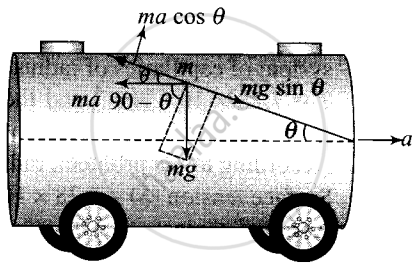Advertisements
Advertisements
प्रश्न
The free surface of oil in a tanker, at rest, is horizontal. If the tanker starts accelerating the free surface will be titled by an angle θ. If the acceleration is a ms–2, what will be the slope of the free surface?
उत्तर
The behaviour of a liquid contained in a horizontally accelerated vessel can be understood by understanding the behaviour of a pendulum suspended from the ceiling of a horizontally accelerated trolley.

Every fluid element attains an equilibrium position under the action of gravity and pseudo-force. The free surface of the liquid orients itself perpendicular to the direction of net effective gravity.
tan θ = a/g
Suppose a tanker accelerates along the x-axis with acceleration a, the free surface of the tanker will not be horizontal because pseudo force acts as shown in the diagram.

Consider an elementary particle of the oil of mass m.
The acting forces on the particle with respect to the tanker are shown in the figure alongside.
Now, balancing forces (as the particle is in equilibrium) along the inclined direction of the surface.
ma = pseudo force
mg = weight of small part of the oil.
Along the free surface,
Net force = 0
⇒ ma cos θ = mg sin θ
⇒ a = g tan θ
⇒ θ = tan-1(a/g)
APPEARS IN
संबंधित प्रश्न
Derive Laplace’s law for spherical membrane of bubble due to surface tension.
Explain why Water on a clean glass surface tends to spread out while mercury on the same surface tends to form drops. (Put differently, water wets glass while mercury does not.)
Frictional force between solids operates even when they do not move with respect to each other. Do we have viscous force acting between two layers even if there is no relative motion?
The rise of a liquid in a capillary tube depends on
(a) the material
(b) the length
(c) the outer radius
(d) the inner radius of the tube
Find the surface energy of water kept in a cylindrical vessel of radius 6.0 cm. Surface tension of water = 0.075 J m−2.
The property of _______ of a liquid surface enables the water droplets to move upward in plants.
Water rises upto a height h in a capillary tube on the surface of the earth. The value of h will increase, if the experimental setup is kept in [g = acceleration due to gravity]
A large number of liquid drops each of radius 'r' coalesce to form a big drop of radius 'R'. The energy released in the process in converted into kinetic energy of the big drop. The speed of the big drop is ______. (T = surface tension of liquid, p = density of liquid)
A hot air balloon is a sphere of radius 8 m. The air inside is at a temperature of 60°C. How large a mass can the balloon lift when the outside temperature is 20°C? (Assume air is an ideal gas, R = 8.314 J mole–1K–1, 1 atm. = 1.013 × 105 Pa; the membrane tension is 5 Nm–1.)
A drop of water of radius 8 mm breaks into number of droplets each of radius 1 mm. How many droplets will be formed?
